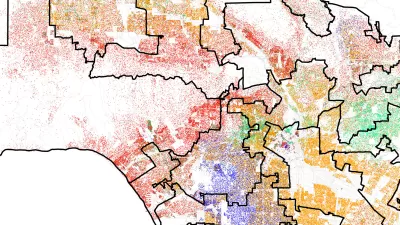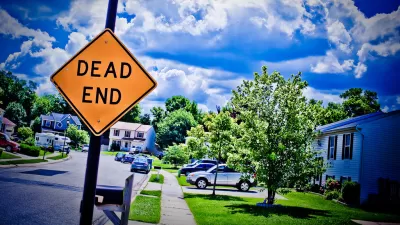Census data is already in for a couple of dozen states, and already blogs are starting to speculate about their lessons for American cities. Some commentators look at the continued decline of Rust Belt cities like Chicago and St. Louis, and suggest that suburban sprawl continues (and will forever continue) unabated. But reality is not quite so simple.
Census data is already in for a couple of dozen states, and already blogs are starting to speculate about their lessons for American cities. Some commentators look at the continued decline of Rust Belt cities like Chicago and St. Louis, and suggest that suburban sprawl continues (and will forever continue) unabated. But reality is not quite so simple.
When commentators argue about whether cities can compete with their suburbs, they don't really mean "all cities"; instead, I suspect they mean "cities that have been losing population to their suburbs." So in examining the early returns from the Census, I focused on two groups of cities: declining cities (those that have lost population since their post-WW II peak) and formerly declining cities (those that have lost population in at least one post-1950 decade, but have recovered and are now more populous than in 1950).
By my count, the Census has issued population data for only nine declining cities with over 200,000 people: Chicago, Baltimore, Washington DC, St. Louis, Newark, Jersey City, Birmingham, New Orleans, and Norfolk. Four of these cities actually gained population in the 2000s: Washington, the two New Jersey cities, and Norfolk- and in three of the cases (all but Jersey City) the city gained population for the first decade since 1970. So if anything, there has been a modest "back to the city" movement in some cities. On the other hand, one city that had gained population in the 1990s (Chicago) slipped backwards.
A second category of formerly declining cities slipped in the mid-20th century, but started to gain population in the last decade or two of that century. This category includes Indianapolis, Fort Worth, Kansas City, Seattle, Denver, Portland, Omaha, Winston-Salem, and Baton Rouge. Not one of these "comeback cities" lost population; it appears that once a city regains its appeal, it keeps growing again. (Caveat: I am sure some of these cities grew by annexing their suburbs).
Of course, all of this could be balanced out by population losses among growing cities. Among cities that consistently gained population in the last half of the 20th century, census data is available for Houston, San Antonio, Dallas, Austin, Charlotte, El Paso, Las Vegas, Oklahoma City, Raleigh, Colorado Springs, Tulsa, Arlington (Texas), Wichita, Aurora, Corpus Christi, Plano, Greensboro, Lincoln, Durham, Laredo, Lubbock, and Garland. Only one of these cities (Tulsa) lost people in the 2000s, and by the narrowest of margins (about 2000 people).
So far it appears that the 2000s has been a better decade for cities than the last decades of the 20th century- albeit not the complete reverse of suburbanization that some pundits appear to yearn for. Not every declining city gained population, but on balance there were more winners than losers, and more winners (if "winning" is defined as "gaining population")* than in prior decades.
Another issue that I find interesting is the relationship between mid-decade Census estimates and the 2010 Census. As yearly Census estimates came in over the past decade, commentators battled over their meaning. Does it matter if a Census estimate in year X shows more big cities growing? Or does it matter more if the trend appears to be reversed in year Y?
Intercensal estimates were not consistently wrong in any one direction. The 2009 estimates showed Chicago and St. Louis growing- results quite contrary to the 2010 Census. But in some cities (such as Washington and Newark), the 2009 Census estimate came within a couple of thousand people of the 2010 result. And the 2009 estimate failed to catch Norfolk's growth, and underestimated Charlotte's growth by 20,000 people. So on balance, the best one can say about intercensal estimates is that they have a margin of error of as much as 11 percent (the amount by which the Census overestimated the 2009 populations of St. Louis and Omaha).
*One could also define "winning" as increased income. This issue I shall address in some future post, I hope.

Manufactured Crisis: Losing the Nation’s Largest Source of Unsubsidized Affordable Housing
Manufactured housing communities have long been an affordable housing option for millions of people living in the U.S., but that affordability is disappearing rapidly. How did we get here?

Americans May Be Stuck — But Why?
Americans are moving a lot less than they once did, and that is a problem. While Yoni Applebaum, in his highly-publicized article Stuck, gets the reasons badly wrong, it's still important to ask: why are we moving so much less than before?

Research Shows More Roads = More Driving
A national study shows, once again, that increasing road supply induces additional vehicle travel, particularly over the long run.

Judge Halts Enforcement of Anti-Homeless Laws in Grants Pass
The Oregon city will be barred from enforcing two ordinances that prosecute unhoused residents until it increases capacity and accessibility at designated camping sites.

Advancing Sustainability in Los Angeles County Schools
The Los Angeles County Office of Education’s Green Schools Symposium brings together educators, students, and experts to advance sustainability in schools through innovative design, climate resilience strategies, and collaborative learning.

Using Old Oil and Gas Wells for Green Energy Storage
Penn State researchers have found that repurposing abandoned oil and gas wells for geothermal-assisted compressed-air energy storage can boost efficiency, reduce environmental risks, and support clean energy and job transitions.
Urban Design for Planners 1: Software Tools
This six-course series explores essential urban design concepts using open source software and equips planners with the tools they need to participate fully in the urban design process.
Planning for Universal Design
Learn the tools for implementing Universal Design in planning regulations.
City of Moreno Valley
Institute for Housing and Urban Development Studies (IHS)
City of Grandview
Harvard GSD Executive Education
NYU Wagner Graduate School of Public Service
City of Cambridge, Maryland
Newport County Development Council: Connect Greater Newport






























